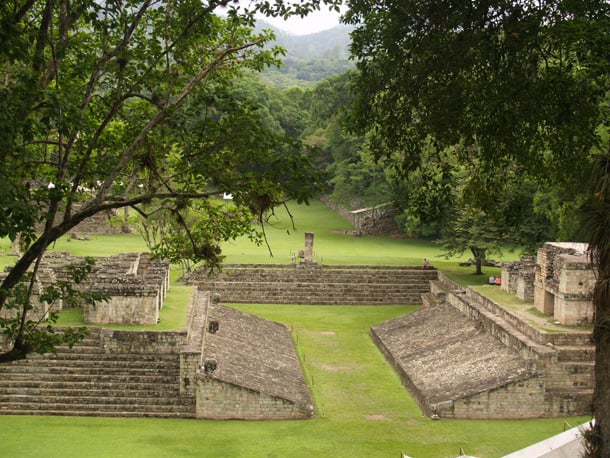The Famous Maya City of Copan: A Site with Abundant Art and Hieroglyphs
Located near the border of present day Guatemala, is the ancient Maya city of Copán. A relatively small Mayan site, it dates back nearly 2,000 years and was once the easternmost city-state in the Maya World. Over the course of 400 years, Copán was shaped from a small valley in western Honduras into a great city with pyramids, temples and statues painted with a range of colors: dark red being the most prevalent of all. It is considered to be the most "artistic" of the Maya cities and is famous for its carved stone sculptures that decorated plazas and temples as well an impressive staircase with the entire history of Copán written on it in Mayan hieroglyphs.
Copán's Rulers: 16 Kings, One Dynasty
Copán began as an agricultural settlement around 1000 BC. As it grew, the site functioned as the political, civil and religious centre of the Copán Valley as well as the center of a larger territory that covered the southeast portion of the Maya area. From the early 400s to 820 AD, a series of 16 kings ruled Copán, all of them belonging to a single dynasty (family).
The Maya leader Yax Kuk Mo, came from the area of Tikal (Petén) and arrived in the Copán Valley in 427 AD. He started the dynasty that transformed Copán into one of the great Maya cities. The greatest period of Copán, paralleled that of other major Maya cities and occurred during the Classical period from 300-900 AD.

An incense burner depicting Yax Kuk Mo. Some people claim that the "goggles" he wears are proof of Ancient Maya contact with aliens, others say they are just part of the ruler's headdress. (Charles Tilford/Ancient History Encyclopedia)
The Fall of Copán
During the 8th century, the 13th king of Copán, lost a battle against a neighboring kingdom and was beheaded. Thereafter the kingdom gradually declined and eventually disappeared. The decline may have been caused in part by internal revolts, war and disease. At its peak, it is estimated that Copán was home to as many as 20,000 people.
- The mystery of the Maya volcanic ash pottery
- New research reveals clues into downfall of Maya civilization
- The Aztec Calendar Wheel and the Philosophy of Time
Copán's Architecture Today
Today, the valley of Copán extends approximately 10 square miles with the site comprising some 250 acres (100 hectares) and has a main complex of ruins along with several secondary complexes. It consists of an Acropolis, stone temples, two large pyramids, stairways, plazas, and tombs. The Eastern Plaza towers above the valley and features a stairway with sculpted jaguars. Near the stairway in the Great Plaza is a ball court with markers resembling macaw heads and was once used for playing the ball game tlachtli (Mayan: pok-ta-pok). It is the second largest court in the Maya World behind the one at Chichen Itza.

Map of the Center of Copán (Wikimedia Commons)
In 2017, Heather Richards-Rissetto, Assistant Professor of Anthropology at the University of Nebraska-Lincoln, launched an ambitious project to bring Copan to life. As BTN LiveB1G reported in November 2017, Richards-Rissetto and her team began MayaCityBuilder to create “an immersive 3D experience” which will “allow visitors to walk the streets of this Mayan capitol during the peak of its power”. Richards-Rissetto explained, “In a sense, you’re walking in the footsteps of an ancient Maya person.” To gain a better perspective of what the original city may have been like, the researchers combined geospatial and 3D mapping software with airborne LiDAR, photogrammetry, and laser scanning.
The Hieroglyph Staircase: A Structure Depicting the History of Copán
Arguably the most notable feature of Copán is the Hieroglyph Staircase. It is not just an amazing feat of architecture and artistry but an important Mayan historical document. The staircase consists of 63 stone steps built on top of a 30 meter (98 feet) high pyramidal structure which leads up to one of the temples.
This hieroglyphic staircase contains over 1250 blocks of stone with 2200 hieroglyphs making it the single longest stone carved text ever found in the ancient Americas. Every step on the stairway is engraved with Maya texts describing the history of Copán. When the structure was first discovered, it was in a state of decay and was re-assembled without an understanding of the language or knowledge of the correct sequence of the blocks. As a result, the text is out of order and the meaning behind the story of the staircases is unknown. What is certain however, is that it is a story about the 16 kings of Copán, starting with Yax K'uk Moh at the base and ending with the death of "18 Rabbit" at the 61st step at the top. The story seems to emphasize the 12th king, K'ak Uti Ha K'awiil, perhaps related to his burial found deep inside the pyramid of the staircase. In the central axis of the stairway are five portraits of previous rulers seated in full military regalia. Their adornments are consistent with warfare, self sacrifice and ancestor worship.

Painting of the hieroglyphic stairway, Copán, Honduras (Scott & Emily/Flickr)
Altar Q: Artwork in Honor of the 16 Rulers
Copán is considered the most famous artistic achievement of the Maya world. Hieroglyphs are found on the majority of monuments at Copán, but it isn’t just hieroglyphs that record the history and traditions of the Maya. The monuments themselves are encoded with imagery and iconography. For example, Alter Q is generally considered one of the more intriguing pieces of artwork at the site. The four sides of this carved stone display the portraits of the 16 rulers of Copán seated on thrones formed by their name glyphs. The image of Yax K'uk Mo' on the side of Altar Q is one of the most detailed in all of Copán, right down to his jewelry. It depicts the ruler wearing ear-flares and a single jade bar. The image also depicts him holding a shield on his right arm, making him a left-handed warrior.

Altar Q, Copán, Honduras (Simon Fraser University Museum)
The Re-Discoveries of Copán
The first European to discover Copán was Spanish explorer Diego García de Palacio in 1570 AD. He wrote a description of the remains of the Maya site to the King Felipe II, but no effort was made to explore the ruins at that time. American explorer John Lloyd Stephens along with British architect and painter Frederick Catherwood rediscovered Copán in 1839. Continuing through the following year they documented the ruins for the first time and are credited with the re-discovery of the Maya civilization. In 1841, Stephens and Catherwood published a book entitled " Incidents of Travel in Central America, Chiapas and Yucatan.” The book was illustrated with engravings based on Catherwood's paintings and was the most detailed description of the Maya culture to be published until that time. These paintings have been in circulation for over 150 years and are credited with introducing the Maya culture to the rest of world.
Throughout the late 1800’s into the 19th century, further expeditions would be made at Copán by various teams of archaeologists. During the 1930s and 1940s the ruins were restored by a group sponsored by the Carnegie Institution of Washington, D.C., and the government of Honduras.
- New study says great Maya city of Tikal literally dried up
- Sacrifice of Maya boy and man may have reenacted birth of sun and moon
- Archaeologists find untouched ruins in their search for the Lost City of the Monkey God
The largest archeological project at the site is Proyecto Arqeológico Copán, which began in 1977 between North-American and Honduran archeologists and has continued ever since.
150 Years and a Well-Documented Maya Site
Also located at the ruins is the Copán Sculpture Museum. Opened in 1996, it began as an international collaboration to preserve Copán’s original monuments and represents the best-known examples of sculptural achievements from this ancient city.
After 150 years of research, Copán is arguably the most well documented Maya site of them all and considered one of the most beautiful and important cities of the civilization. It was declared a UNESCO World Heritage site in 1980 and attracts more than 150,000 national and international tourist visits each year.
For more information on the Maya Ruins at Copán, Honduras, watch this video:
Featured Image: The Ballcourt at Copán, Honduras (public domain)
By Bryan Hill
References
"Copán." Uncovered History. http://uncoveredhistory.com/honduras/Copan/.
"Maya Site of Copán." UNESCO World Heritage Centre. http://whc.unesco.org/en/list/129.
"Copán National Park General Information." Copán Park. http://www.Copanpark.com/generalinfo.htm.
"Copán | Ancient City, Honduras." Encyclopedia Britannica Online. http://www.britannica.com/place/Copan.
"Maya Ruins at Copán." This Is Honduras. http://thisishonduras.com/Copan-Ruinas.htm.
Fash, Barbara W. The Copán Sculpture Museum: Ancient Maya Artistry in Stucco and Stone. Cambridge, Mass.: Peabody Museum Press & David Rockefeller Center for Latin American Studies, Harvard University, 2011.
Sharer, Robert. "Copan Altar Q." Expedition Magazine Copan Altar Q Comments. April 1, 2012. http://www.penn.museum/sites/expedition/copan-altar-q/.
""Lost King of the Maya"" PBS. http://www.pbs.org/wgbh/nova/transcripts/2804maya.html.
"Copan - a 3D Reconstruction." YouTube. October 1, 2014. https://www.youtube.com/watch?v=x37KuIs2Sfo.
"HONDURAS Copán / DIRECTED BY CESAR RICARDO NUNEZ." YouTube. 2013. https://www.youtube.com/watch?v=3yxfScPYjng.

















